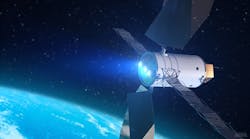Within the next decade, NASA's Glenn Research Center expects to launch a low-fuel, lightweight, solar-powered spaceship. Solar Electric Propulsion (SEP) is paving the way for new efficient technologies, and being used in missions that may facilitate outer-space inhabitance. It’s anticipated that the renewable-source ships will expedite future deliveries to space stations, and possibly turn our solar system into an expansive highway, or even an interworking residency.
The new SEP ship electric propulsion system is expected to cut the weight of a spaceship in half, meaning more liftoffs at a lower price, and greater fuel economy. After liftoff, the SEP ships will use ten times less propellant than contemporary chemical propulsion systems.
Thin, lightweight, and with high surface area and strength, the foldable solar-panel sheets will expand like paper fans, or roll out like carpets for sun exposure after liftoff. They will capture photonic energy from the sun and use it to create electron flow over the semiconductors in the photovoltaic cells. The new solar-power technology can decrease the weight by half and cut space used by energy-storage components by 75%.
The ships will incorporate Hall Thruster engines, where flowing electrons will be “caught” in a magnetic field. These electrons are then used to ionize xenon, a gaseous propellant in the thrusters.
Watch a video on Hall Thrusters, courtesy of Engineering TV, below:
Xenon is an inert (stable, or non-reactive) noble gas with a large atomic radius. Because its electrons are not held in close to the nucleus, it requires low energy to remove an electron from Xenon’s valence shell (i.e., it has low ionization energy). This ionization causes xenon to flow out from the ship’s exhaust as plasma, propelling the ions at speeds of up to 65,000 mph.
